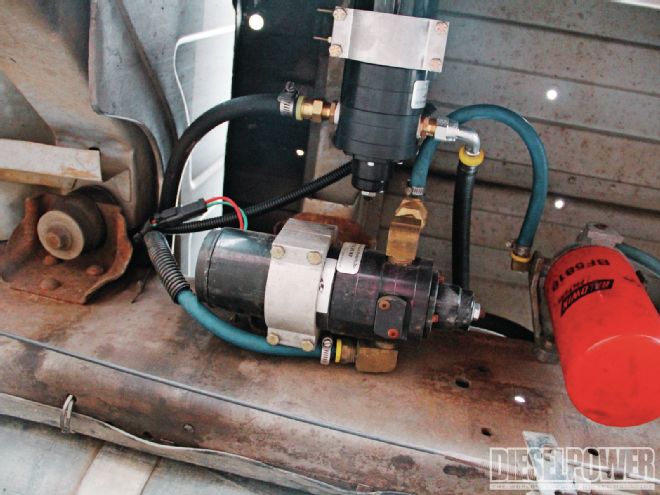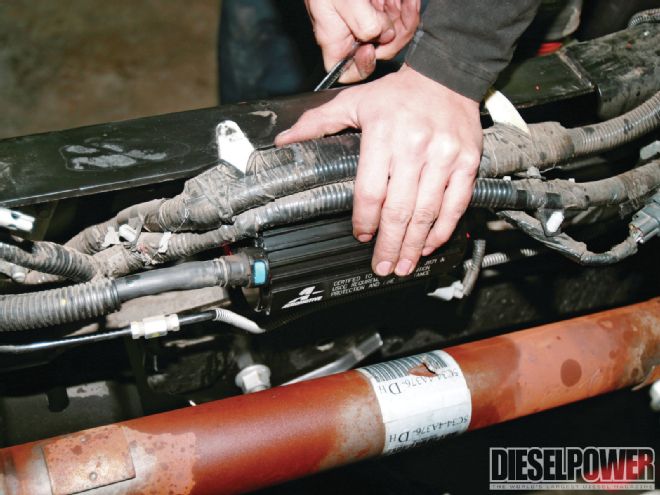We use the term “lift pump” in Diesel Power all the time, but newcomers to the industry might be a little confused about what a lift pump actually does, when you need one, and which one you might need. In this section, we’re looking to explain the various types of lift pumps, and how they relate to your diesel engine.
What’s a Lift Pump?
Whether you own a Power Stroke, Cummins, or Duramax-powered rig (or something else altogether), a lift pump can simply be defined as a low-pressure supply pump that is used to transmit fuel to a high-pressure pump. In the case of most mechanical engines, fuel pressure is fed to an injection pump, where it is ramped up to more than 15,000 psi through the injection pump and injector. In the case of newer, electronically controlled trucks, a high-pressure pump (CP3, CP4, or Siemens) creates the pressure (in some cases more than 30,000 psi), which is then fed to a common high-pressure fuel rail, and then the injectors are used to meter injection events. In either variety, keeping steady pressure available for the high-pressure pump is vital to the engine’s performance.

| This picture illustrates why air and water separation systems such as this AirDog unit have become so popular. With a filter, fuel pump, and water separator all in one unit, all that’s left is to run lines to the tank and the engine.
When Do You Need One?
When fuel pressure to a high-pressure pump drops, bad things can happen. Power loss is one of the most obvious scenarios, as low, or no fuel pressure means a pressure drop occurs in the high-pressure pump, which affects power and can actually cause injection pump failure.
Bigger Filters, Lines, and More Pressure
When trying to make more power, there is a point (which occurs sooner on older trucks) when the factory fuel filters, lines, and pump all become inadequate. It’s for this reason that complete fuel systems, like those from FASS or AirDog (or the new Fuelab units), are so popular. With these filter/pump/line systems, all the lift pump issues are addressed in one fell swoop, and the truck owner can go about his merry way making horsepower without worrying about a bottleneck.
More Power
Most lift pump companies cite superior water separation and better supply pressure as reasons to purchase their product, but in most cases, a higher-pressure lift pump can add power, too. In Project Triple Threat, our ’95 Dodge project, we saw nearly 35 more horsepower across the board by taking fuel pressure from 10 psi (at wide-open throttle) to 35 psi. While this pressure was beyond the factory specifications, it helped add a good deal of power. On Feature Editor Mike McGlothlin’s 7.3L-powered Power Stroke, a gain of 9 hp with an upgraded Walbro lift pump was realized, proving that horsepower from supply pump pressure isn’t application specific.

| Many aftermarket electric pumps that are in use in the gasoline world are also rated for diesel fuel use. Pumps from Edelbrock, Carter, and Holley can all be used as either pusher pumps to feed a factory lift pump, or fed straight into the injection pump. In this case, it’s recommended that ½-inch or larger fuel lines be used throughout the system.
Types of Lift Pumps
In older OEM applications, most lift pumps are mechanical, which means they’ll likely last the life of the vehicle but are also at a fixed fuel pressure and have a fairly consistent volume. Electric pumps, on the other hand, can be adjusted for pressure or volume, regulated, or boosted via extra voltage to provide more flow. While FASS and AirDog are the two big companies in the diesel market, we’ve also seen people use Holley, Walbro, Carter, Aeromotive, MagnaFuel, Fuelab, and Edelbrock lift pumps with success. One advantage of using a pump that has been designed for the gasoline/alcohol market is price, another is high flow and higher pressures (45-plus psi) than standard diesel pumps.
Limits
One of the beautiful things about lift pumps is that they are easily upgraded. For most people, the question is whether they need a 100- to 150-gph lift pump, or something larger? While upgrading is easy, buying twice usually isn’t. It’s been our experience that most trucks with a programmer, intake, exhaust, mild injectors, or turbo upgrade can live with a less-than-150-gph lift pump. For engines with big injectors, stroker high-pressure pumps, or engines that spin a lot of rpm (sled pullers), upgrading to a 150-plus-gph pump is recommended. When shopping, make sure to ask the manufacturer about the flow specifications at your desired pressure, as we’ve seen the same pump flow 140 gph at free flow (no pressure) or 80 gph at 14 psi of pressure.

| Heavily fueled tunes, big injectors, and dual fuelers (or modified mechanical pumps) are all add-ons that can make fuel pressure drop like a rock. If you’re looking for 800-plus to the wheels, a lift pump that can flow in the 200-gph range is recommended.
Which Pump to Buy
Honestly, most lift pumps are pretty good, and most that are rated for gasoline are also OK with diesel fuel, although you should always check with the manufacturer first. If you’re the type of person who is on a budget and wants to build your own system, a Carter Marine pump (low pressure) or Walbro GSL392 (high pressure) lift pump can suit your needs. For high-performance use, FASS, AirDog, or Fuelab all offer diesel-specific kits for any power level, while companies like MagnaFuel and Aeromotive have very high pressure and flow pumps that are great for 1,000-plus-hp applications. Whatever decision you make, do your research first—and be honest about the usage and application of your vehicle.

| An interesting newcomer to the diesel market is Fuelab, which has introduced 100- and 200-gph lift pumps complete with water separation and filter units. With brushless motors, no shaft seals to fail, and the ability to produce good flow at higher pressures, these units look very promising in terms of performance and durability.
Lift Pump Q&A
Q: Can I run parallel lift pumps if one isn’t enough?
A: We don’t know about mixing and matching flows and brands, but we do know of people who’ve run 150-gph lift pumps, figured out that wasn’t enough, put another 150-gph pump in the mix, and install a Y-fitting to the injection pump. If one lift pump fails, you also have an immediate backup.
Q: There’s a pump the owner says was rebuilt a few years ago and has been sitting on a shelf since; should I buy it? It’s a good deal.
A: We’d advise against this one. Buying used lift pumps can be trouble, as leaky seals or worn-out motors are a definite possibility. This isn’t the area you want to be cheap, as a failed pump can cause big, expensive problems. We recommend you pony up the dough for a new one.
Q: What’s the most impressive lift pump out there?
A: Waterman Racing designs supply pumps capable of up to 600 psi and 7,000 gph flow (these are the pumps used on Top Fuel dragsters), but there’s no way you’ll need that type of flow on any diesel. Waterman does, however, make lift pumps that are rated for 300 to 500 gph, which many of the top sled pullers use.
Q: Is more fuel pressure always better?
A: Not always. VE injection pumps found in ’89 to ’93 Dodge trucks, for instance, will blow out the front seal if too much supply pressure is run. In that application, a maximum pressure of 15 psi is recommended, unless steps are taken to reinforce the front seal. On many dual-fueler common-rail applications, the controllers and electronics will freak out if they see too much pressure and suffer from an inconsistent idle or defuel at odd times. Always consult the manufacturer about your specific application (as well as reputable Internet sites, and Diesel Power magazine) before you max out your lift pump pressures.
Q: What if I just stick with the stock lift pump?
A: If you keep the stocker, most likely your truck will live a long and happy life…if it’s stock. Once it has been modified with more fueling, an aftermarket lift pump is a very good idea.
Q: OK, I’m sold. How much are lift pumps?
A: Depending on the application, they’ll run about $200 to $700, which is pretty good for insurance against damage, more power, and better filtering and air separation.

